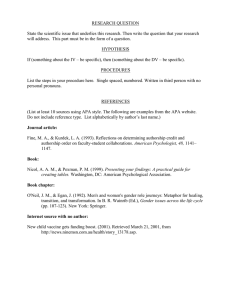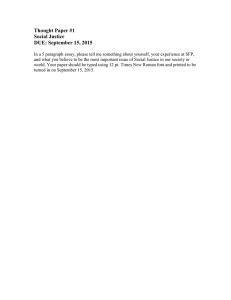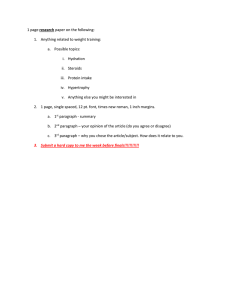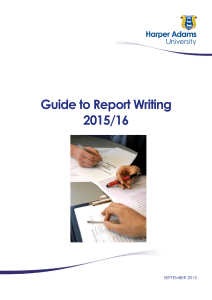1 THE TITLE OF YOUR PROJECT GOES 3” FROM THE TOP... IS MORE THAN ONE LINE, THE SECOND LINE SHOULD BE...
advertisement
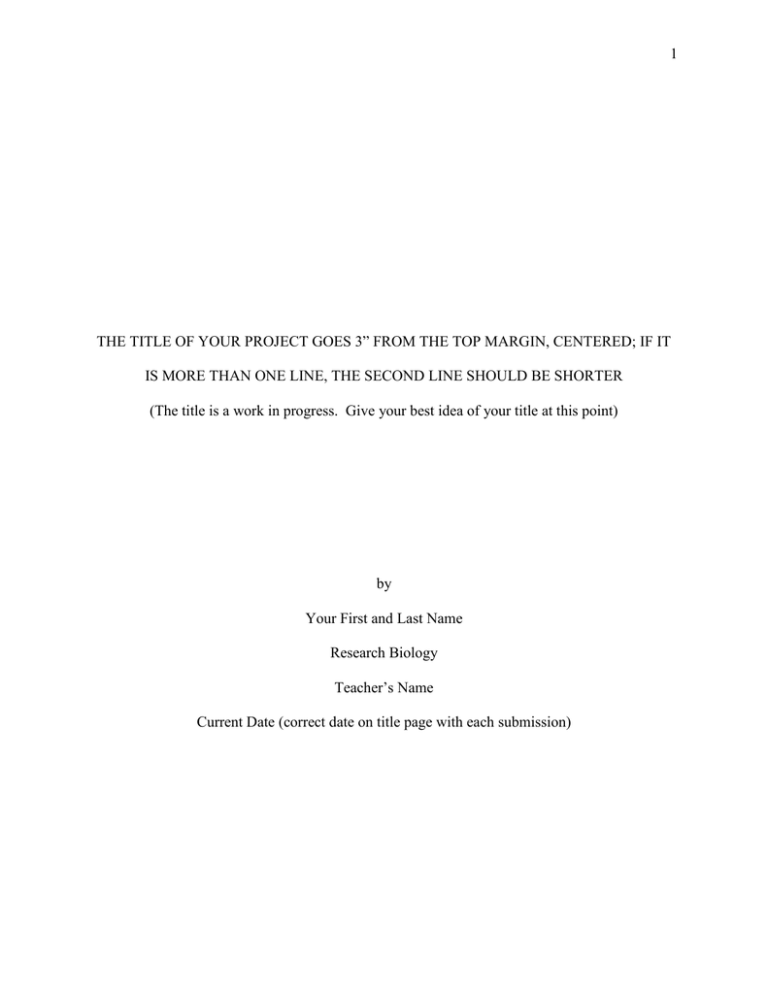
1 THE TITLE OF YOUR PROJECT GOES 3” FROM THE TOP MARGIN, CENTERED; IF IT IS MORE THAN ONE LINE, THE SECOND LINE SHOULD BE SHORTER (The title is a work in progress. Give your best idea of your title at this point) by Your First and Last Name Research Biology Teacher’s Name Current Date (correct date on title page with each submission) 2 TABLE OF CONTENTS Statement of the Problem ............................................................................................................ 3 Hypothesis ................................................................................................................................... 4 Literature review ......................................................................................................................... 5 Materials ...................................................................................................................................... 6 Procedures ................................................................................................................................... 7 Results ......................................................................................................................................... 8 Conclusions ................................................................................................................................. 9 References ................................................................................................................................. 10 The page numbers show actual pages that the sections start on. The above table of Content has been auto-setup (i.e. when you add info in your document, the page number updates will be taken care of by Word). You just need to refresh the table of contents (Press F9 and select “update whole table”) and make sure that the font of the Table is “Times New Roman size 12”). You can do this by highlighting the font and changing the font and size on the toolbar. If you have questions, see your teacher. For your information: How to create an automatic Table of Contents (like the one above): - Click on “References” - Select “Table of Content” on the left-hand side - Select “Automatic Table 2” - 3 STATEMENT OF THE PROBLEM Double-spaced. What is the question you are trying to answer? 4 HYPOTHESIS State your educated guess as to the outcome of the experiment (No "I", " We"," You") . What is your prediction about the experiment? Try to state it in an “If…., then….” Statement or prediction statement. Remember, NO personal pronouns (I, we, you). This may be altered after you conduct your Literature Review and learn more about your topic. However, it must be finalized before you conduct your study/experiment. 5 LITERATURE REVIEW Indent paragraphs 5 spaces. A paragraph has at least 3 sentences. Each paragraph has a topic sentence, supporting sentences and an ending sentence. Write in 3rd person. Do not use the words "you" or "I". The literature review section of your paper should be at least 500 words of information related to your topic. Citations should be used instead of any type of footnote or endnote. The citation should be located at the end of a sentence or paragraph and should be in the following form (Author, year). Your paper should be full of citations. Make all revisions indicated by your teacher on your first draft and any edits/revisions thereafter until the final draft is complete. 6 MATERIALS List all the materials used….do not use a numbered list. Use plain list as shown. One 100 ml graduated cylinder Three 500 ml glass beakers Ten 5cm x 5cm pieces of tin foil 7 PROCEDURES 1. List the steps to conduct your experiment so that another person could duplicate it. 2. The steps must be numbered. 3. Do not write in first person (no I, we, you) 4. Identify the IV, DV, and control group 5. Describe constants 6. Be VERY specific 8 RESULTS This section will be blank until you actually have results. Remember: Tables and Graphs go after the results section, but before the conclusions section. 9 CONCLUSIONS This section will be blank until you have analyzed your results and performed statistical analysis. 10 REFERENCES All sources used and cited within your literature review should be included in alphabetical order (NOT numbered). The first line of an entry is NOT indented; the second and all other lines are indented. (See examples below). You must have 10 sources APA style (Fifth Edition). Fine, M. A., & Kurdek, L. A. (1993). Reflections on determining authorship credit and authorship order on faculty-student collaborations. American Psychologist, 48, 1141– 1147. Nicol, A. A. M., & Pexman, P. M. (1999). Presenting your findings: A practical guide for creating tables. Washington, DC: American Psychological Association. O'Neil, J. M., & Egan, J. (1992). Men's and women's gender role journeys: Metaphor for healing, transition, and transformation. In B. R. Wainrib (Ed.), Gender issues across the life cycle (pp. 107-123). New York: Springer. New child vaccine gets funding boost. (2001). Retrieved March 21, 2001, from http://news.ninemsn.com.au/health/story_13178.asp.

